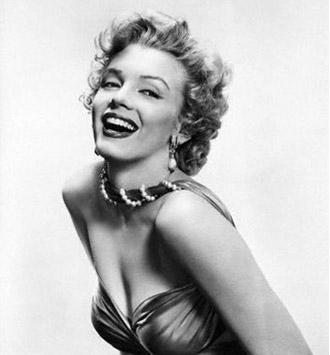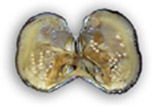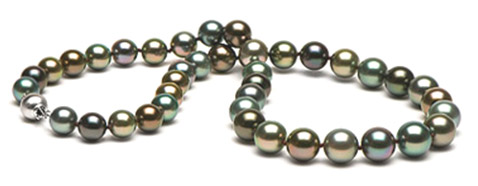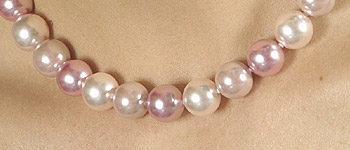
For centuries pearls enchanted people, being a fascinating gift of the bosom of the sea, which is perfect in its beauty and uniqueness. The beauty of pearls is primeval and is entirely created by nature itself: pearls do not need any special treatment to look splendid.
Both now and always on all continents pearls were among the greatest treasures, symbolizing power and wealth. No other stone, metal or gem ever boggled people’s imagination more than pearls, due to its delicate, soft and calm glow.
Wearing pearls has always been a sign of belonging to high society. If diamonds are girl’s best friends, then lady’s best friends are, undoubtedly, pearls. Among the admirers of pearls are such ladies, as Cleopatra, Marilyn Monroe, Princess Diana, Simone Signoret, Elizabeth Taylor, Jackline Kennedy, Milla Jovovich and Cameron Dias. Remaining a classic gem, pearls would never be out of fashion.

Gemstone - pearl
Pearl is a unique natural material. It is widely used in jewelry. Pearl jewels were always considered to be a luxury.
Pearl is among the most popular gems used in jewelry, as it has organic nature, and is produced by special kind of mollusks – pearl oysters.
Pearl appears as a result of overlapping of one layer of nacre on the other. The thicker the nacre, the more beautiful the pearl is. Natural pearls are those pearls, which developed without human interference, when foreign object accidentally got into oyster’s gonad. Natural pearls are the rarest gemstones, which is the reason for their considerable prices. Nowadays most of the pearls marketed are the cultured ones. “Cultured” pearls were grown with human intervention. A foreign object, called the “nucleus”, is implanted into the oyster, after which the process of nucleation continues the same, as with the natural pearls.
Nowadays cultured pearls are usually used in jewellery. Pearls remain women’s favourite jewelry irrespective of social class, yet the most expensive and of the highest quality belong to only a few of them. The quality of pearls determines how they look and their cost. Constantly increasing popularity of pearls favours the accretion of demand and their cost
Cultured pearls
It is a mistake to consider cultured pearls to be imitation. Cultivation of pearls is extremely complicated and delicate process, which takes from three to eight years. People, who cultivate pearls, are practically precluded from an opportunity to influence the process and a result of the pearl development; they do not know, how the ready-made pearl would look like, as well as they can not guarantee that a mollusk would not prematurely expel it. By no means are all nucleated pearls compliant with quality standards – this business has considerably high risk of rejection. The final result primarily depends on nature only.
Today 99% of pearls in the world jewelry market is cultured pearls. Cultured pearls are also natural pearls, as they are cultivated in natural conditions in pearl-oysters, though under the human control and with his help.
There are two basic ways of nucleation – using a “bead” (the bead or nucleus is implanted into the oyster’s gonad; this method is used to cultivate saltwater pearls) and without a bead. The second way is less expensive and became wide-spread to cultivate freshwater pearls, especially in China.
Here is the first way. At first, a donor oyster is selected. Usually this is a young oyster with good mantel tissue. Oyster-recipient has to have a well-developed gonad (so called genesial gland, which secrets nacre). The shell is opened with pliers and a delicate surgical operation is performed: using special instruments a small incision is made in the gonad and a transplant, a small piece of mantle tissue taken from a donor oyster, is placed in it. The bead of 6-9 mm in diameter, taken from freshwater bivalve, is placed beside. After nucleating, oyster is taken back to lagoon, where it spends the next two years in piece. This is the most dangerous time: it can die or expel the nucleus (the bead) – there is a high probability of this to happen. If everything happens without complications, in a few years time a pearl will appear.

Among the outer advantages is an ideal surface of the pearl, as the nacre surrounds the regular artificial bead. The factual thickness of nacre in such pearl is from 0, 2 to 1 mm. Such 10 mm pearl grows in one (!) year only. This could be called a natural pearl only by stretching a point. When holding such in hand, it immediately warms up, as any other piece of plastic – even the inexperienced person will distinguish at once a natural, weighty and cold pearl from the weightless, easily heated plastic imitation.
The advantages of the second way of nucleation lay in the fact that using small-enough nucleus, which is as small as the grain of sand, and a long-lasting process of nucleation, cultured pearl is highly competitive with the natural one by its size and colour.

Nowadays most of the freshwater pearls of no more than 8-9 mm in size, are being grown using unnucleated technology, using a piece of mantle tissue only, taken from the shell itself.
Cultured pearls, in their turn, are divided into two types – freshwater and saltwater pearls, which depends on the mollusk’s habitat.
Freshwater pearls
Freshwater pearls grow in freshwater rivers or lakes and even in former rice fields in China. These fields are filled with water, so that a comfortable microclimate for mollusks would be created, in which they could reproduce fast and give birth to fine pearls. “Pearl farmers” constantly control water temperature, its composition and pH level. During the process of pearl developing, the mollusk has to be turned over from time to time, so that the pearl would not be “lopsided”. In the long run, it is a hard work to cultivate round pearls, even in “hothouse” conditions of the farm.

Freshwater pearls are very popular due to variety of shapes, colours and size. There are pearls of 2 to 8 mm in diameter, yet the average size is 4 to 6 mm. Extremely rare size of freshwater cultured pearls is more than 10 mm in diameter.

"Hyriopsis schlegeli" is the most widely spread freshwater mollusk, which originates from the family Unionide. The external sides of the shell are usually of brown colour, the internal sides, however, are smooth and white.

Freshwater pearls, as contrasted to saltwater ones, do not have a nucleus. The exceptions are the pearls, the size of which is more than 10 mm. After the 1, 5 years of time, the pearl reaches the size of approximately 3 mm. In three years time it can reach the size of 7 mm. More than 7 mm in size can be reached only in case the pearl would be left for four years more to develop. These are the common colours of pearls: white, cream, champagne-colour, orange-rose, lilac, light violet and brown.

The shapes vary from oval, egg-shaped, drop-shaped to potato-shaped ones. Extremely rare are perfectly round and large pearls.

Saltwater pearls
Saltwater pearls are valued more than freshwater ones. Usually, pearls have sufficiently regular shape and fine luster. Saltwater pearls grow faster than the freshwater ones. Marine pearl-producing mollusk lifespan is no more than 8-10 years. Pearls are more often to appear in marine mollusks. Most of the pearls, suitable for jewellery, are produced by the marine mollusks from genus Pinctada. The size of such shells is from 7 to 20 cm in diameter, while their mass reaches 10 kg. The traditional regions of cultivation are the south seas.
One pearl-producing mollusk can produce no more than one, less frequently three pearls at once, though there are well-known unique exceptions, like, for example, the unbroken record of pearl oyster from genus Pteria, found in the Sea of Japan, inside which 620 pearls were found over a 25 cm² area.
Saltwater pearls are being harvested at the same farms, but on the open sea.

Opposed to fresh water, salt water adds pearl a special shade and slightly more solid colour, which is why it is more valued. Yet, there is one “but”:
It is extremely difficult to protect mollusks from storms and water temperature extremes. Even two degrees temperature change causes the mollusk to secret weak acid, which immediately corrodes the upper layer of nacre; it goes without saying that it grows turbid and loses its luster without a trace. Thus, pearl farmers often loose in one day the result of the years of work. That is why to reduce pearl production time, nowadays most of sea farms use the nucleus.
The most popular types of saltwater cultured pearls are Akoya Pearls and South Sea Pearls.
Cultured Akoya pearls are cultivated on sea in the south of Japan. The best harvest of Akoya pearls is collected at the period from the end of autumn to the beginning of winter. The pearls get their best luster at this time.

Akoya Pearl reaches 9 mm in diameter and is very expensive. The cost of the pearl beasts off with every millimeter, as long as its diameter has reached 8 mm. Akoya pearls are mostly cultivated in Japan, yet now China has also started to export these.
The process of manufacturing a jewelry made from cultured pearls is preceded by a long period of cultivation, which is the same for almost all types of pearls.
South Sea pearl is rare, expensive and falls in the premium class in the market. White and goldish pearls are produced in Australia and Indonesia, while the black pearls – in Tahiti and the French Polynesian islands.

Though the process of cultivation is practically the same, as for Akoya pearls, South Sea pearls are considerably larger: the size of a pearl reaches 6-20 mm.

The reason for this is the fact that the waters near the northern coast of Australia are the native habitat of a unique oyster, the size of which reaches 30 cm. These oysters are harder to cultivate and the pearl harvest is less in proportion than the Japanese one, which is the reason for these pearls to be so expensive.
In addition, the structure and the thickness of nacre of the Australian pearl are better, than of the Japanese one.
Tahitian Pearls or Black Pearls. Each black pearl is a fine creation of nature. None of them ever repeat another in shape.
Black pearl is a perfection itself. It needs neither any special treatment, nor reshaping. Any type of it, whether it is of round shape, pear-shaped or a button pearl, is extremely valued, as it requires no chemical treatment: pearls extracted from oyster are already clean, dry and smooth enough. Yet, by no means all black pearls in jewelry stores are naturally black. Sometimes, jewelers paint white pearls on purpose, to create a special effect. Nevertheless, this would be an imitation, even of high quality. The best natural black pearl of highest quality is produced in Tahiti.

This pearl is distinguished for its iridescence in the sun light, as well as its unusual “metallic” colouring, which is uncommon for other types of saltwater pearls. It is commonly considered that Tahitian pearls are mostly “black”, which is why their second name appeared – “black pearls”, though, in fact, they are grey with more of less light shades. In addition, there are pearls of this type with absolutely untypical colouring: for example, blue (peacock colour), violet (eggplant colour), green, olive green, light blue and even red (magenta). The most valuable and, consequently, the most expensive ones, are iridescent blue and cobalt blue colourings.
Each black pearl is a fine nature’s creation. None of them ever repeats the shape and the delicate shades of another. That is why it is extremely difficult to create a black pearl necklace. A jeweler has to look through thousands of pearls, before he or she can create a unique necklace. After all, the requirements are serious enough: each pearl in a necklace has to be of a round shape only, no less than 12 mm in diameter each, and, finally, be perfectly matched by colour. Such necklace can sometimes cost a man his fortune. The matching process takes years. Not every jeweler has the luck to create such masterpiece. Nature creates too little perfect black pearls. Sometimes there are no matching beads even for ear-rings.

Black pearl always plays a key role. Its very uniqueness brings inspiration to the jeweler with its swarthy, hot and bewitching pearl luster. No wonder that the black pearl jewelry is always extravagant. They can make a woman illustrious, unique and hard to forget. Yes, black pearl for every woman is a love potion, her constant renewal, search for herself, eternal exploration of the unfathomed deeps of her personality, a discovery of a mysterious desert island in the ocean of her soul.
Natural Pearl
Type of pearls: Natural pearls
Country of origin: Produced in various countries
Kind of mollusk: Several kinds of mollusks, both freshwater and saltwater
Pearl characteristics: The investment grade pearl, subject to careful selection, regular shape, both round and oval, gives a vivid reflection of the objects surrounding, bright luster. The size may vary.

Imitation
In addition to natural and cultured pearls, there are other artful types of pearls. For example, mabe pearls – are intentionally grown pearls. Its production technology is the following: a plastic nucleus is implanted against the inner side of the oyster's shell. In 6-12 months time the developed pearl is cut out of the shell. The nucleus is then removed and the coreless shell remains. It is being toned or coloured with paint or a piece of mother-of-pearl. Then the shell is filled with resin and, finally, capped with a piece of mother-of-pearl to complete the mabe pearl. Certainly, mabe pearls, which have resin as their nucleus, are rather cheaper, then the natural ones.
One can not omit mentioning imitations. As far back as in XV-XVI centuries the Indians learned to produce pearl beads, which resembled natural pearls, or clay beads, which, after they were burnt in isinglass, resembled pearls. They got nacre by scraping it off the shells. Modern technologies are liable to various materials. This can be glass, plastic, pearl, alabaster and other synthetic and natural materials and their mixtures. For example, the production of imitations of Majorica pearls includes several strictly respected technological stages. As a result of the process, which is similar to natural pearl development, the alabaster nucleus is covered layer by layer with pearl essence. This essence is produced from processing of marine organic elements, which are, in simple terms, fish scale. After every covering the future pearl is dried, polished and the next layer of essence is applied over; this happens up to the moment, when the specialists will make certain of sufficient thickness of layer, luster and glow.
And, finally, synthetic pearls, which are, in fact, no pearls at all. They are produced by anyone who would take the trouble of various shapes and sizes. They are also inexpensive.

